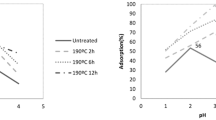Abstract
Hydrogen adsorption characteristics of woodceramics, made from radiata pine wood fiber boards carbonized at 1 473K after impregnation with phenolic resin, with and without chemical treatment in an alkaline (KOH) or an acid (H2SO4) solution were investigated The hydrogen adsorption capacity is improved by chemical treatment. The chemical treatment by KOH improves the adsorption capacity more than by H2SO4. The improvement of the capacity level, in any solution, is dependent on the type of chemical in the solution and its concentration. The maximum hydrogen capacity measured at 93K is mass fraction about w(H) = 2% for the woodceramics after chemical treatment in a volume fraction φ = 50% KOH solution, although that is about w(H) = 0.7% for one without chemical treatment. The microscopic condition of pores in the woodceramics is thought to vary after chemical treatment.
Similar content being viewed by others
References
Okabe T, Saito K, Hokkirigawa K. New porous carbon materials, woodceramics: Development and fundamental properties [J]. Journal of Porous Materials, 1995, 2: 207–213.
Kano M, Momota M, Okabe T, et al. Specific heat capacity of new porous carbon materials: Woodceramics [J]. Thermochimca Acta, 1997, 292(1–2): 175–177.
Shibata K, Okabe T, Sauto K. Electromagnetic shielding properties of woodceramics made from wastepaper [J]. Journal of Porous Materials, 1997, 4: 269–275.
Dillon A C, Jones K M, Bekkedahl T A, et al. Storage of hydrogen in single-walled carbon nanotubes [J]. Nature, 1997, 386: 377–379.
Chambers A, Park C, Terry R, et al. Hydrogen storage in graphite nanofibers [J]. Journal of Physical Chemistry B, 1998, 102(22): 4253–4256.
Orimo S, Majer G, Fukunaga T, et al. Hydrogen in the mechanically prepared nanostructured graphite [J]. Applied Physics Letter, 1999, 75(20): 3093–3095.
Rosi N L, Eckert J, Eddaudi M, et al. Hydrogen storage in microporous metal-organic frameworks [J]. Science, 2003, 300: 1127–1129.
Mulder F M, Assfour B, Huot J, et al. Hydrogen in the metal-organic framework Cr MIL-53 [J]. Journal of Physical Chemistry C, 2010, 114: 10648–10655.
Takasaki A, Otsuka H, Okabe T. Hydrogen absorption and adsorption characteristics of woodceramics transactions [J]. Journal of Materials Research Society of Japan, 2005, 30(4): 1151–1154.
Gijs Schimmel H, Kearly G J, Nijkamp M G, et al. Hydrogen adsorption in carbon nanostructures: Comparison of nanotubes, fibers, and coals [J]. Chemistry-A European Journal, 2003, 9(19): 4764–4770.
Author information
Authors and Affiliations
Corresponding author
Rights and permissions
About this article
Cite this article
Takasaki, A., Iijima, S., Yamane, T. et al. Hydrogen adsorption by woodceramics produced from biomass. J. Shanghai Jiaotong Univ. (Sci.) 17, 330–333 (2012). https://doi.org/10.1007/s12204-012-1280-2
Received:
Published:
Issue Date:
DOI: https://doi.org/10.1007/s12204-012-1280-2




